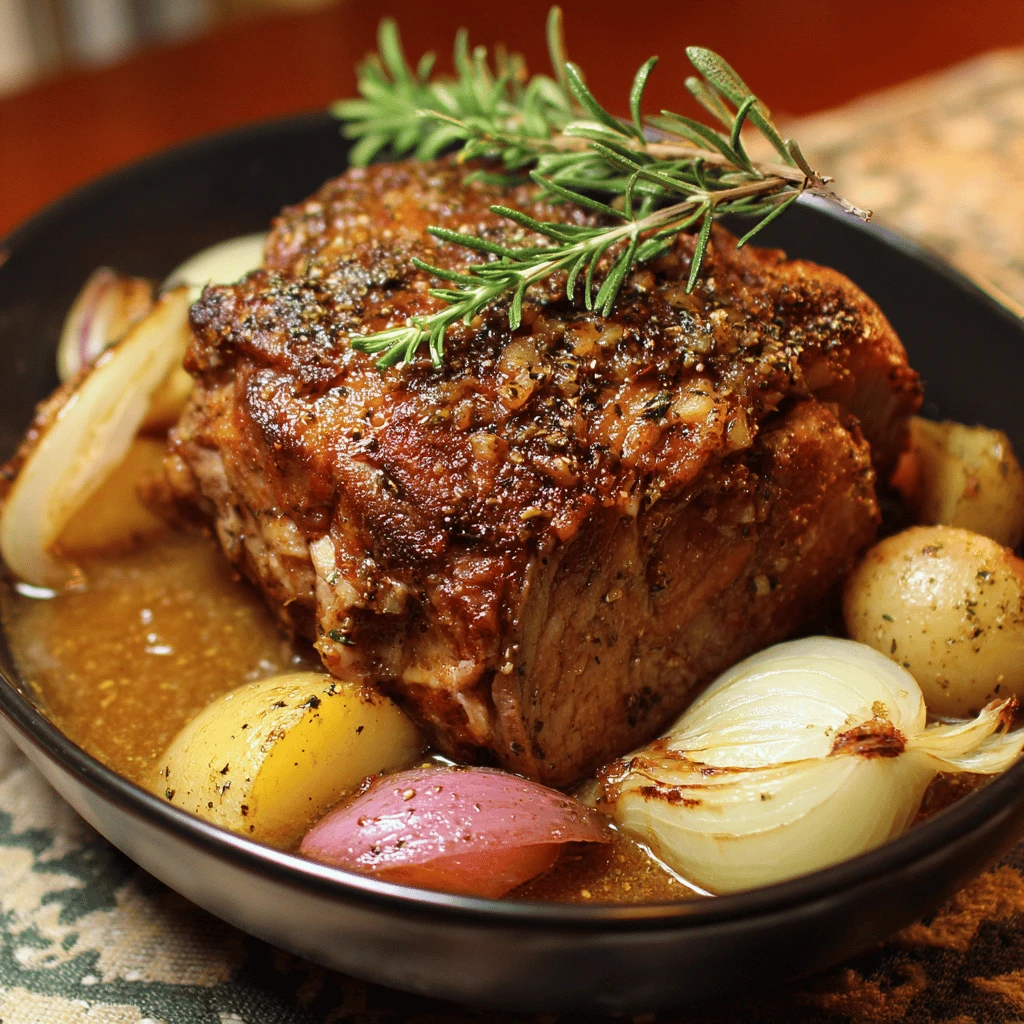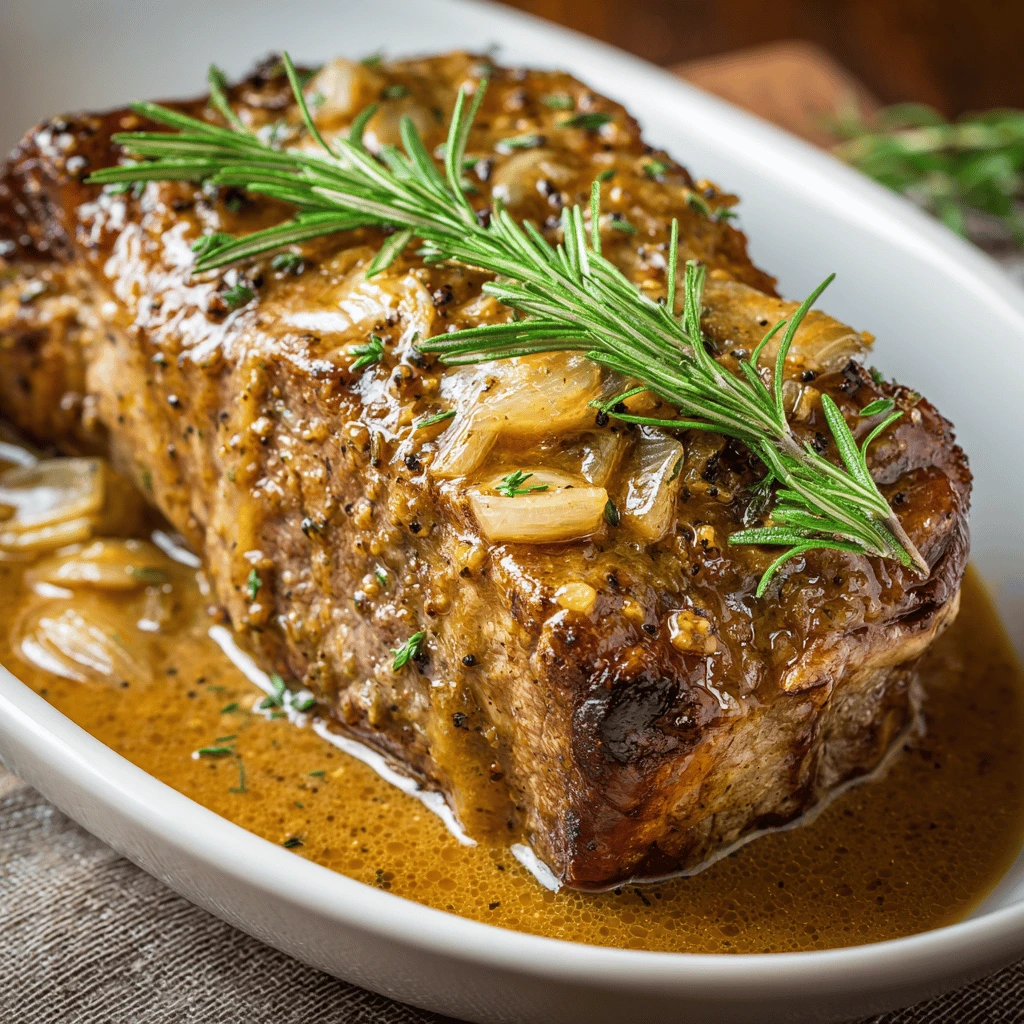Crockpot Maple Dijon Pork Roast
Ingredients
- 3-4 lb boneless pork shoulder roast (also known as pork butt)
- 1/2 cup Dijon mustard
- 1/4 cup maple syrup (real maple syrup recommended)
- 2 tablespoons apple cider vinegar
- 1 tablespoon olive oil
- 1 teaspoon dried thyme
- 1 teaspoon dried rosemary
- 1/2 teaspoon garlic powder
- 1/4 teaspoon black pepper
- 1/2 teaspoon salt, or to taste
- 1 medium yellow onion, sliced
- 2 cloves garlic, minced
- 1 cup chicken broth or apple cider
Step-by-Step
1. In a small bowl, whisk together the Dijon mustard, maple syrup, apple cider vinegar, olive oil, thyme, rosemary, garlic powder, salt, and pepper. This creates the delicious maple Dijon glaze.
2. Place the sliced onion in the bottom of your crockpot.
3. Rub the pork roast all over with the minced garlic.
4. Pour the maple Dijon mixture evenly over the pork roast, ensuring it’s well coated.
5. Place the coated pork roast on top of the sliced onions in the crockpot.
6. Pour the chicken broth or apple cider around the roast.
7. Cover the crockpot and cook on low for 6-8 hours, or on high for 3-4 hours, or until the pork is very tender and easily shreds.
8. Once cooked, remove the pork roast from the crockpot and place it on a cutting board.
9. Using two forks, shred the pork.
10. Skim off excess fat from the sauce in the crockpot.
11. Return the shredded pork to the crockpot and stir to coat with the sauce.
12. Serve hot on buns, over mashed potatoes, rice, or with your favorite side dishes.
Serving Suggestions and Variations
Slow cooker pork roast is incredibly versatile. Its sweet and savory flavor profile complements a wide range of sides and presentations. Don’t be afraid to experiment and find your favorite way to enjoy this dish.
Classic Comfort Food Pairings
For a classic comfort food meal, serve the shredded pork roast over mashed potatoes or creamy polenta. The rich sauce soaks beautifully into the starches, creating a hearty and satisfying dish. Steamed green beans or roasted carrots make excellent vegetable companions.
Another popular option is serving the pork on toasted buns for delicious pulled pork sandwiches. Top with coleslaw for added crunch and flavor. Consider offering a variety of barbecue sauces for guests to customize their sandwiches.
Creative Twists and Sides
Looking for a more creative approach? Try serving the pork in tacos or quesadillas with your favorite toppings. The sweet and savory flavor works surprisingly well in Mexican-inspired dishes.
Roasted sweet potatoes provide a wonderful contrast to the richness of the pork. The sweetness of the potatoes complements the maple Dijon glaze. Quinoa or couscous are healthy and flavorful grain options that pair well with the pork.
Adjusting the Flavor Profile
If you prefer a spicier dish, add a pinch of red pepper flakes to the glaze or use a spicy Dijon mustard. For a more tangy flavor, increase the amount of apple cider vinegar. A splash of Worcestershire sauce can also add depth of flavor to the sauce.
Experiment with different herbs and spices to customize the flavor to your liking. Smoked paprika, cumin, or chili powder can add a smoky or Southwestern twist. Fresh herbs like parsley or cilantro can brighten up the dish.
Choosing the Right Pork Roast
Selecting the right cut of pork is crucial for a successful crockpot recipe. Different cuts have varying levels of fat and connective tissue, which affect the final texture and flavor of the roast. Pork shoulder, also known as pork butt, is generally the best choice for slow cooking.
Understanding Pork Shoulder (Pork Butt)
Pork shoulder is a relatively inexpensive cut of meat that becomes incredibly tender and flavorful when cooked low and slow. It has a good amount of fat marbling throughout, which renders down during cooking, keeping the meat moist and succulent. The collagen breaks down, creating a melt-in-your-mouth texture.
When shopping, look for a pork shoulder roast that is well-marbled with fat. This will ensure that the pork remains moist and flavorful throughout the cooking process. You can choose a bone-in or boneless roast. Boneless roasts are easier to shred, while bone-in roasts may impart slightly more flavor.
Other Pork Roast Options
While pork shoulder is the ideal choice, you can also use other cuts of pork for this recipe, although the results may vary slightly. Pork loin roast is a leaner cut of meat that can become dry if overcooked. If using pork loin, be sure to cook it on low and monitor its internal temperature carefully.
Pork tenderloin is another lean option, but it cooks much faster than pork shoulder or loin. It’s not ideal for slow cooking, as it can become tough. If you want to use pork tenderloin, consider searing it before adding it to the crockpot and reducing the cooking time significantly.
Sourcing and Quality
Whenever possible, choose high-quality pork from a reputable source. Look for pork that is raised without antibiotics or hormones. Consider purchasing pasture-raised pork for the best flavor and texture.
Tips for Crockpot Success
Achieving perfectly tender and flavorful pork roast in the crockpot is easier than you think. A few simple tips and tricks can make all the difference. From searing the pork to adjusting the cooking time, these guidelines will help you create a consistently delicious meal.
Searing the Pork (Optional)
While not strictly necessary, searing the pork roast before adding it to the crockpot can enhance its flavor and appearance. Searing creates a beautiful brown crust that adds depth and complexity to the dish.
To sear the pork, heat a tablespoon of oil in a large skillet over medium-high heat. Sear the roast on all sides until it’s browned. This step adds a rich, caramelized flavor to the pork.
Adjusting Cooking Time
The cooking time for crockpot pork roast can vary depending on the size of the roast and the specific crockpot. Use a meat thermometer to ensure that the pork is cooked to a safe internal temperature of 190-205°F (88-96°C) for optimal shredding.
If the pork is not tender enough after the recommended cooking time, continue cooking it for another hour or two. Avoid overcooking the pork, as it can become dry. The pork should easily shred with two forks when it’s done.
Controlling the Sauce Consistency
The sauce in the crockpot may be thin after cooking. To thicken it, you can remove the lid from the crockpot and cook on high for another 30-60 minutes, allowing some of the liquid to evaporate.
Alternatively, you can make a slurry of cornstarch and water and add it to the crockpot during the last 30 minutes of cooking. This will help to thicken the sauce quickly. Remember to skim off any excess fat from the sauce before serving.
Make-Ahead and Storage Instructions
Crockpot Maple Dijon Pork Roast is an excellent make-ahead meal. It’s perfect for busy weeknights or for entertaining guests. Properly storing and reheating the leftovers will ensure that they remain flavorful and delicious.
Preparing in Advance
You can prepare the pork roast ahead of time by rubbing it with the spice mixture and storing it in the refrigerator overnight. This allows the flavors to meld together, resulting in a more flavorful dish.
Alternatively, you can cook the pork roast in the crockpot ahead of time and store it in the refrigerator or freezer. This is a great option if you’re short on time or if you want to have a meal ready to go.
Storage and Reheating
Store leftover shredded pork roast in an airtight container in the refrigerator for up to 3-4 days. For longer storage, freeze the pork in a freezer-safe container for up to 2-3 months.
To reheat the pork, you can microwave it, warm it in a skillet, or reheat it in the crockpot. If reheating in the crockpot, add a little broth or water to prevent it from drying out.
Utilizing Leftovers
Leftover Crockpot Maple Dijon Pork Roast can be used in a variety of creative ways. Add it to salads, sandwiches, or wraps. Use it as a topping for pizzas or nachos. Incorporate it into soups or stews for added flavor and protein.
Health Benefits and Considerations
While Crockpot Maple Dijon Pork Roast is a delicious and satisfying meal, it’s important to be mindful of its nutritional content. Choosing lean cuts of pork and using natural sweeteners can help make this dish a healthier option.
Nutritional Information
Pork is a good source of protein, which is essential for building and repairing tissues. It also contains important vitamins and minerals, such as iron, zinc, and B vitamins. However, pork can also be high in fat and cholesterol.
The nutritional content of Crockpot Maple Dijon Pork Roast will vary depending on the specific ingredients used. Using a leaner cut of pork, such as pork loin, and reducing the amount of maple syrup can help lower the fat and sugar content.
Making it Healthier
To make this dish healthier, consider using a natural sweetener, such as honey or agave nectar, instead of maple syrup. You can also reduce the amount of Dijon mustard to lower the sodium content.
Serve the pork with plenty of vegetables to create a balanced meal. Choose whole-grain buns for sandwiches or serve the pork over quinoa or brown rice.
Dietary Considerations
Crockpot Maple Dijon Pork Roast is generally gluten-free, but it’s important to check the labels of all ingredients to ensure that they are gluten-free. It may not be suitable for people following a strict paleo or ketogenic diet due to the maple syrup.
FAQ
Here are some frequently asked questions about making Crockpot Maple Dijon Pork Roast.
Can I use a different cut of pork?
Yes, while pork shoulder is recommended, you can use pork loin. Adjust cooking time accordingly.
Can I add vegetables to the crockpot?
Absolutely! Potatoes, carrots, and other root vegetables work well. Add them in the last few hours of cooking.
Can I make this in an Instant Pot?
Yes, you can adapt this recipe for an Instant Pot. Sear the pork first, then cook on high pressure for about 60-75 minutes, followed by a natural pressure release.
How do I thicken the sauce?
Remove the lid during the last 30-60 minutes of cooking or add a cornstarch slurry.
Can I use honey instead of maple syrup?
Yes, honey can be used as a substitute for maple syrup. The flavor will be slightly different.




